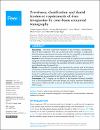Prevalence, classification and dental treatment requirements of dens invaginatus by cone-beam computed tomography

View/
Date
2022-12-05Author
Yalcin, Turgut YagmurKayhan, Kıvanç Bektaş
Yilmaz, Ayca
Göksel, Sevde
Ozcan, İlknur
Yigit, Dilek Helvacioglu
...show more authors ...show less authors
Metadata
Show full item recordAbstract
Background. This study aimed the evaluation of the prevalence, characteristics, types of dens invaginatus (DI) and co-observed dental anomalies to understand dental treatment requirements in anterior teeth that are susceptible to developmental anomalies by using cone-beam computed tomography (CBCT). Methods. In this retrospective study, the anterior teeth of 958 patients were evaluated by using CBCT for the presence of DI. The demographic features, types of DI and treatment requirements were also recorded. The association between sex and the presence of DI was evaluated using chi-squared test. Results. Seventy-three DI anomalies were detected in the anterior teeth of 49 patients (18 females, 31 males). The frequency of DI was 5.11% and the most frequently involved teeth were lateral (57.53%). Forty-six teeth were classified as Type I (63.01%), 24 as Type II (32.87%), and three as Type III (4.10%). Apical pathosis was found to be 20.54% in all DIs detected and accounted for all Type III and one-third of Type II. Conclusions. CBCT imaging can be effective in the detection of dental anomalies such as DI and planning for root canal therapy and surgical treatments. Prophylactic interventions might be possible to prevent apical pathosis with the data obtained from CBCT images.
Collections
- Dental Medicine Research [396 items ]

